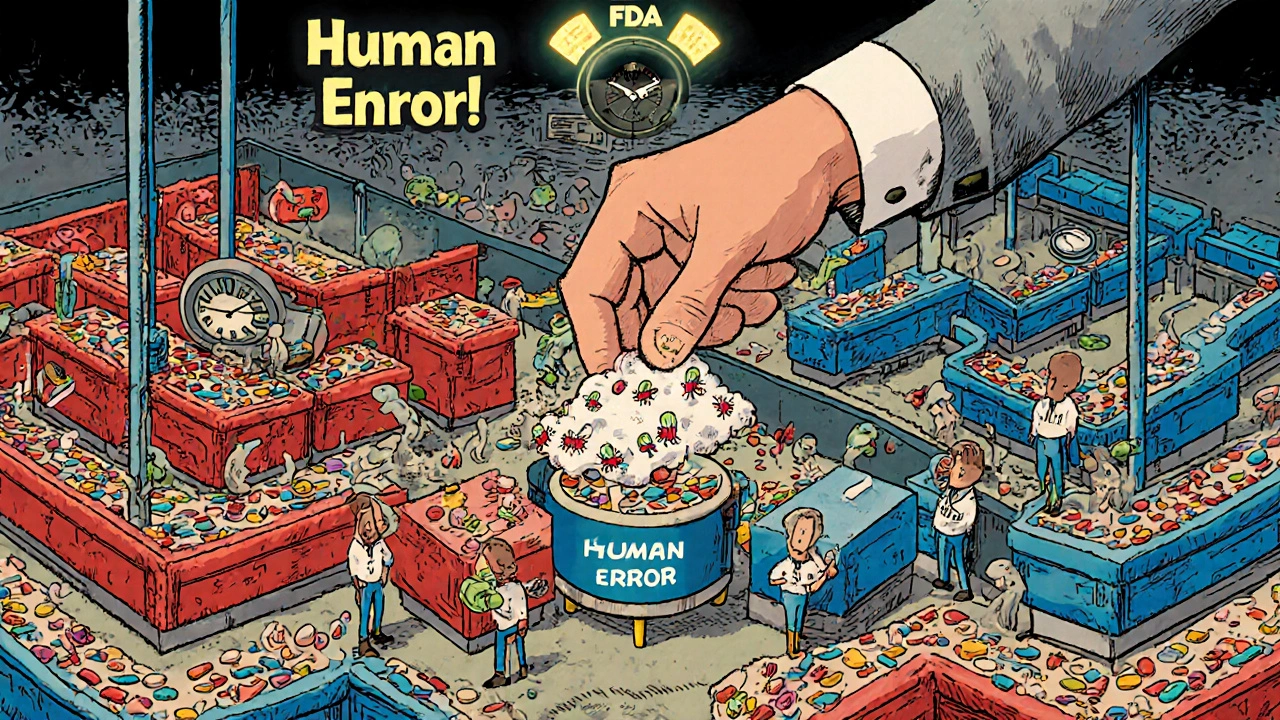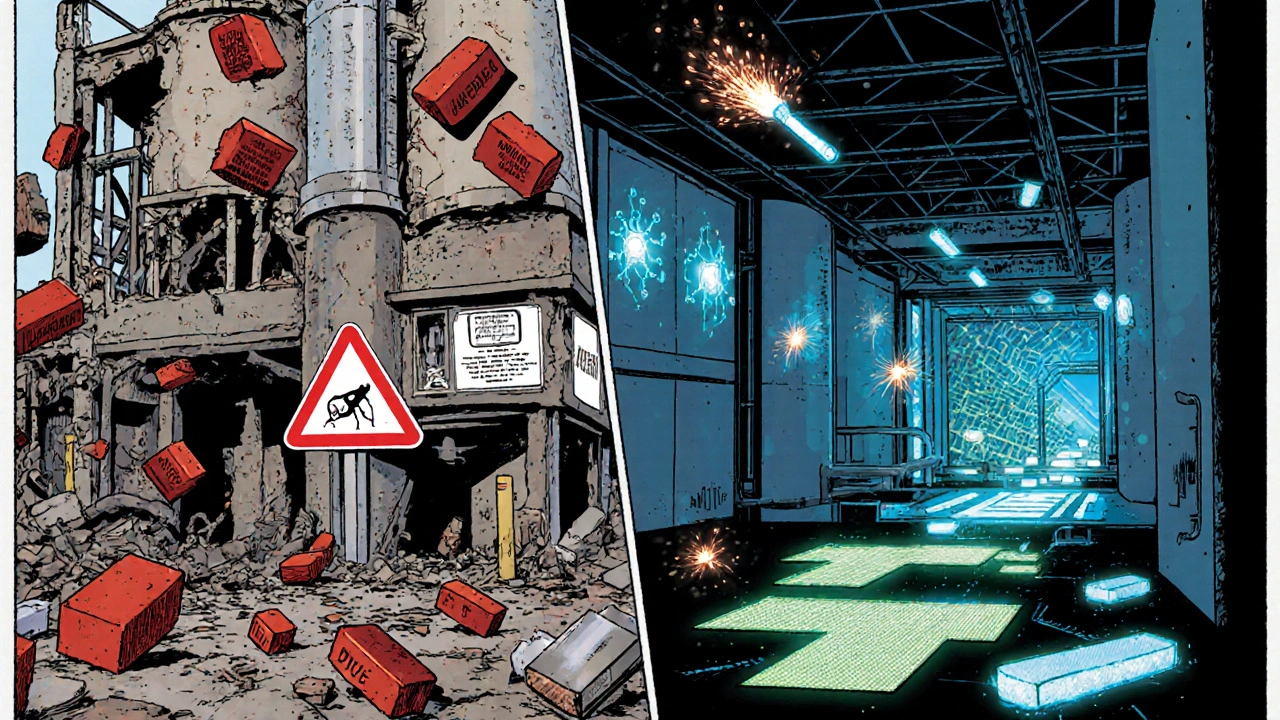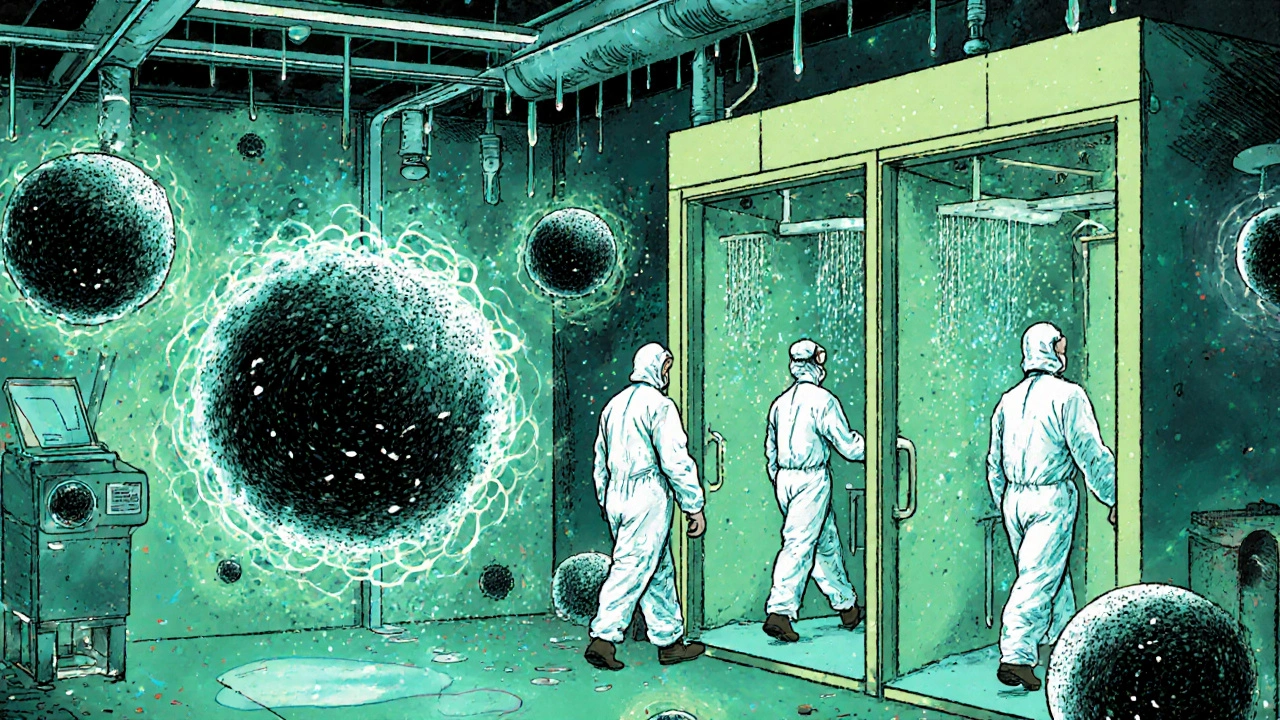Why contamination control isn’t optional in generic drug manufacturing
Generic drugs make up 90% of prescriptions filled in the U.S., but they account for only 22% of total drug spending. That price pressure doesn’t mean quality can slip. When a generic medication gets contaminated-whether by chemicals, microbes, or leftover active ingredients from a previous batch-it doesn’t just cost money. It puts lives at risk. In 2020, nitrosamine contamination in valsartan led to global recalls affecting 22 manufacturers. The losses? Over $1.2 billion. And that’s just one incident. The FDA issued warning letters for contamination-related violations in 37.2% of all pharmaceutical inspections in 2022. This isn’t a rare problem. It’s the biggest single reason generic drug facilities get shut down.
What counts as adulteration-and how regulators define it
The FDA defines a drug as adulterated if it’s made, packed, or stored under conditions that could make it unsafe. That means anything from dirty equipment to airborne particles settling on tablets. It’s not just about visible dirt. A single nanogram of a potent drug residue left on a surface can be enough to cause harm if it ends up in the next batch. The same goes for bacteria. If your tablet has more than 10 colony-forming units (CFU) per 25 cm², it’s rejected. That’s less than a speck of dust. And it’s not just the FDA. The European Medicines Agency (EMA) set even stricter limits in 2014, requiring manufacturers to prove they can control cross-contamination down to the nanogram level for high-potency drugs.
How cleanrooms and airflow keep drugs safe
Most generic drug manufacturing doesn’t happen in a lab coat and gloves. It happens in cleanrooms with controlled air. ISO Class 5 (Grade A) rooms are used for filling sterile products-these rooms must have no more than 3,520 particles larger than 0.5 micrometers per cubic meter. That’s like trying to keep a football field free of sand grains, but in the air. Behind those cleanrooms are HVAC systems that change the air 20 to 60 times every hour. Pressure differences between rooms are kept at 10-15 Pascals so air always flows from clean to less clean areas, never the other way. Airlocks, dedicated corridors, and unidirectional flow paths aren’t luxuries. They’re the only way to stop a worker walking from the packaging area into the filling zone from dragging contaminants with them.
Real-time monitoring beats manual checks
For years, manufacturers relied on manual swabs and lab cultures that took 5 to 7 days to give results. By then, the batch was already shipped. Today, real-time particle counters like the MetOne 3400+ are changing the game. These devices track airborne particles every second. A 2022 ISPE study showed facilities using them reduced contamination incidents by 63%. Why? Because manual checks miss 78% of transient events-a sneeze, a door opening, a glove tear. ATP bioluminescence systems now give results in 5 minutes instead of days, with 95% accuracy compared to traditional cultures. They’re not cheap-$15,000 to $25,000 per unit-but for a facility that’s had a recall, the ROI is obvious.

Human error is the #1 cause of contamination
It’s not the machines that fail most often. It’s people. A 2023 PDA survey of 217 generic manufacturers found that 47% of contamination events were due to human error. That includes improper gowning, skipping cleaning steps, or mislabeling equipment. One Teva Pharmaceuticals employee reported a 30% spike in gowning violations after switching to reusable isolation gowns-until they spent $185,000 on upgraded air showers to remove particles before entering cleanrooms. Color-coded equipment reduced mix-ups by 65% in another facility. Simple fixes, but they only work if people follow them. Training isn’t optional. A 2021 AstraZeneca study showed gowning compliance dropped 40% after 8 hours of a 12-hour shift. Fatigue is a contamination risk.
Cleaning validation: the silent gatekeeper
After making one drug, you have to clean the equipment before making another. That’s cleaning validation. And it’s not just rinsing with water. You have to prove you removed every trace of the previous product. The standard? Less than 10 parts per million (ppm) of chemical residue. For microbial limits, it’s under 10 CFU per 25 cm². Swabbing and rinse sampling are standard, but new rapid microbiological methods (RMMs) cut testing time from 7 days to 48 hours. Software like ValGenesis helps track this-but it takes 147 hours of training per user, according to a 2022 survey. That’s a full three weeks of work just to learn how to use the system. And if you don’t train properly, you’ll miss contamination. That’s why some facilities use Dycem CleanZone mats under foot traffic areas. One Pfizer generics facility reported a 72% drop in foot-borne contamination after installing them.
One batch at a time: a simple fix with big results
Many generic manufacturers run multiple products on the same line to save money. But that’s risky. A case study in Pharmaceutical Engineering showed that switching to a "one batch at a time" model cut cross-contamination incidents by 53%. No overlapping production. No shared equipment between incompatible drugs. It sounds basic, but it’s a game-changer. It means you need more equipment, more space, and more planning. But it also means fewer recalls, fewer inspections, and faster regulatory approvals. Freyr Solutions found that facilities using this approach got approved 40% faster based on 158 inspection reports from 2020-2022.

The cost of getting it right-versus the cost of getting it wrong
Innovator companies spend $185 million on facilities for the same output that a generic manufacturer builds for $80 million. But generics don’t win by cutting corners. They win by being smarter about operations. Real-time monitoring, rigorous cleaning protocols, and human behavior management cost money. But not investing? That’s far more expensive. The FDA is increasing inspection frequency by 27% for facilities with past contamination issues. The EMA rejected 41% of generic drug applications in 2022 due to contamination control gaps. And starting in 2025, the FDA will require health-based exposure limits (HBELs) for every product. That’s a $1.2 million investment per facility just to comply. Smaller manufacturers can’t afford to wait. Those who act now will survive. Those who don’t? They’ll be out of business.
What’s next: AI, sustainability, and global alignment
The future of contamination control isn’t just about bigger filters or stricter rules. It’s about prediction. Honeywell’s Forge Pharma system uses AI to analyze sensor data and predict contamination risks before they happen-cutting false alarms by 68% in a Merck pilot. Sustainability is pushing innovation too. GlaxoSmithKline cut utility costs by 22% using waterless cleaning tech. And globally, ICH Q13 guidelines for continuous manufacturing, finalized in June 2023, now include contamination controls as a core requirement. This isn’t just a U.S. or EU issue. It’s becoming the global standard. The companies that adapt fastest won’t just pass inspections. They’ll set the new benchmark.
What is the biggest cause of contamination in generic drug manufacturing?
Human error is the leading cause, accounting for 47% of contamination events, according to a 2023 PDA survey. This includes improper gowning, skipping cleaning steps, equipment mix-ups, and fatigue during long shifts. While equipment and raw materials contribute, the majority of failures stem from procedural lapses by staff.
How often should cleaning validation be performed?
Cleaning validation must be performed after every change in product, equipment, or cleaning procedure. It’s not a one-time test. Facilities must validate cleaning for each active pharmaceutical ingredient (API) and demonstrate residue levels stay below 10 ppm for chemicals and 10 CFU per 25 cm² for microbes. Ongoing monitoring with rapid methods is now expected to confirm consistency between formal validations.
What’s the difference between ISO Class 5 and ISO Class 8 cleanrooms?
ISO Class 5 (Grade A) is for critical aseptic processes like sterile filling and requires no more than 3,520 particles ≥0.5μm per cubic meter. ISO Class 8 (Grade D) is for less critical areas like packaging or raw material storage, allowing up to 35,200,000 particles per cubic meter. The difference isn’t just cleanliness-it’s airflow, pressure control, and gowning requirements. Class 5 rooms need laminar airflow and full sterile gowns; Class 8 rooms use standard cleanroom attire.
Why are real-time particle counters better than manual sampling?
Manual sampling catches only a snapshot-usually once per shift. Real-time counters monitor continuously, detecting spikes from door openings, sneezes, or equipment malfunctions within seconds. A 2022 ISPE study found manual methods miss 78% of transient contamination events. Real-time systems reduce contamination incidents by 63% and provide actionable data to stop problems before batches are compromised.
What’s the 2025 FDA deadline for contamination controls?
By 2025, all generic drug manufacturers must implement health-based exposure limits (HBELs) for every product, as outlined in the FDA’s September 2023 draft guidance. HBELs determine the maximum safe level of cross-contamination allowed between products. Facilities that don’t comply will face increased inspection scrutiny, potential shutdowns, and rejection of drug applications. The estimated cost to implement HBELs is $1.2 million per facility.
Can small generic manufacturers afford modern contamination controls?
Yes-but they need to prioritize. You don’t need a $2 million system to be compliant. Start with high-risk areas: implement color-coded equipment, use Dycem mats to reduce foot contamination, switch to rapid microbiological testing, and train staff on one batch at a time production. Real-time monitoring can be phased in. The biggest cost isn’t equipment-it’s the price of a recall or a shutdown. Smaller manufacturers who delay risk being pushed out of the market as regulators tighten standards.
What to do next if you’re in generic manufacturing
If you’re running a generic drug facility, start with a risk assessment using ICH Q9 guidelines. Identify your top three contamination risks-likely human error, cleaning validation gaps, or raw material handling. Then pick one low-cost, high-impact fix: color-code your equipment, install Dycem mats at entry points, or switch to ATP testing for cleaning validation. Don’t wait for an FDA warning letter. The market is shifting. Facilities that act now will survive. Those that don’t will be left behind.

